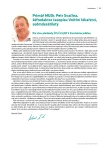Complications associated with joint replacements in diabetic patients
Authors:
Pavel Šponer; Tomáš Kučera; David Pellar
Authors‘ workplace:
Ortopedická klinika LF UK a FN Hradec Králové, přednosta doc. MUDr. Pavel Šponer, Ph. D.
Published in:
Vnitř Lék 2015; 61(6): 567-570
Category:
Předneseno na mezioborovém sympoziu s postgraduálním zaměřením „Diabetik – společný pacient diabetologa a ortopeda“ 10. října 2014 v Hradci Králové
Overview
While a joint implant is the method of choice for numerous locomotor disorders and it is indicated for diabetic patients based on the same rules as for patients without diabetes mellitus, a joint implant in diabetic patients is associated with a high risk of perioperative complications. Considering a very difficult and demanding treatment of a deep infection of a joint replacement, the prevention of complications plays the key role. A precondition for adequate perioperative preparation and correctly managed perioperative and postoperative care of patients with diabetes mellitus is the close cooperation of the orthopedist, diabetologist and anesthesiologist, who in their practice have to respect the specificities of their diabetic patients presented in submitted reports.
Key words:
arthroplasty – complication – diabetes mellitus
Sources
1. Wiklund I, Romanus B. A comparison of quality of life before and after arthroplasty in patients who had arthrosis of the hip joint. J Bone Joint Surg Am 1991; 73(5): 765–769.
2. Vavřík P, Landor I, Popelka S et al. The national register of joint replacements of the Czech republic. Hip joint replacements. Selected outputs and their analysis for the period 2003–2012. Acta Chir Orthop Traumatol Čech 2014; 81(Suppl): 3–68.
3. Meding JB, Reddleman K, Keating ME et al. Total knee replacement in patient with diabetes mellitus. Clin Orthop Relat Res 2003; (416): 208–216.
4. Cordero-Ampuero J, de Dios M. What are the risk factors for infection in hemiarthroplasties and total hip arthroplasties? Clin Orthop Relat Res 2010; 468(12): 3268–3277. Dostupné z DOI: <http://dx.doi.org/10.1007/s11999–010–1411–8>.
5. Jain NB, Guller U, Pietrobon R et al. Comorbidities increase complication rates in patients having arthroplasty. Clin Orthop Relat Res 2005; (435): 232–238.
6. Landor I (ed). Revizní operace totálních náhrad kyčelního kloubu. Maxdorf: Praha 2012. ISBN 978–80–7345–254–4.
7. Dandona P, Aljada A, Chaudhuri A et al. Metabolic syndrome: a comprehensive perspective based on interactions between obesity, diabetes, and inflammation. Circulation 2005; 111(11): 1448–1454.
8. Einhorn TA, Boskey AI, Gundberg CM et al. The mineral and mechanical properties of bone in chronic experimental diabetes. J Orthop Res 1988; 6(3): 317–323.
9. Robertson HD, Polk HC. The mechanism of infection in patients with diabetes mellitus: a review of leucocyte malfunction. Surgery 1974; 75(1): 123–128.
10. Reddy GK, Stehno-Bittel L, Hamade S et al. The biomechanical integrity of bone in experimental diabetes. Diabetes Res Clin Pract 2001; 54(1): 1–8.
11. Tsang STJ, Gaston P. Adverse peri-operative outcomes following elective total hip replacement in diabetes mellitus. A systematic review and meta-analysis of cohort studies. Bone Joint J 2013; 95-B(11): 1474–1479.
12. Singh JA, Lewallen DG. Diabetes: A risk factor for poor functional outcome after total knee arthroplasty. Plos One 2013; 8(11): e78991. Dostupné z DOI: <http://dx.doi.org/10.1371/journal.pone.0078991>.
13. Bolognesi MP, Marchant MH, Viens NA et al. The impact of diabetes on perioperative patient outcomes after total hip and total knee arthroplasty in the United States. J Arthroplasty 2008; 23(6 Suppl 1): 92–98.
14. Iorio R, Williams KM, Marcantonio AJ et al. Diabetes mellitus, hemoglobin A1C, and the incidence of total joint arthroplasty infection. J Arthroplasty 2012; 27(5): 726–729.e1. Dostupné z DOI: <http://dx.doi.org/10.1016/j.arth.2011.09.013>.
15. Gandhi R, Petrucelli D, Devereaux PJ et al. Incidence and timing of myocardial infarction after total joint arthroplasty. J Arthroplasty 2006; 21(6): 874–877.
16. Kapoor A, Labonte AJ, Winter MR et al. Risk of venous tromboembolism after total hip and knee replacement in older adults with comorbidity and co-occurring comorbidities in the Nationwide Inpatient Sample (2003–2006). BMC Geriatr 2010; 10:63. Dostupné z DOI: <http://doi: 10.1186/1471–2318–10–63>.
17. Tsukayama DT, Estrada R, Gustilo RD. Infection after total hip arthroplasty. A study of the treatment of one hundred and six infections. J Bone Joint Surg Am 1996; 78(4): 512–523.
18. Jahoda D, Sosna A, Nyč O. Infekční komplikace kloubních náhrad. Triton: Praha 2008. ISBN 978–80–7387–158–1.
19. Haddad FS, Masri BA, Campbell D et al. The PROSTALAC functional spacer in two-stage revision for infected knee replacements. Prosthesis of antibiotic-loaded acrylic cement. J Bone Joint Surg Br 2000; 82(6): 807–812.
20. Rizvi AA, Chiloag SA, Chiloag KJ. Perioperative management of diabetes in hyperglycemia in patients undergoing orthopaedic surgery. J Am Acad Orthop Surg 2010; 18(7): 426–435.
21. Haverkamp D, Klinkenbijl MN, Somford MP et al. Obesity in total hip artroplasty – does it really matter? A meta-analysis. Acta Orthop 2011; 82(4): 417–422.
22. Lubbeke A, Moons KGM, Garavaglia G et al. Outcomes of obese and nonobese patiens undergoing revision total hip arthroplasty. Arthritis Rheum 2008; 59(5): 738–745.
Labels
Diabetology Endocrinology Internal medicineArticle was published in
Internal Medicine

2015 Issue 6
Most read in this issue
- Diagnosing and therapy of gout
- Alveolar echinococcosis – rare cystic disease of the liver – editorial
- Guidelines of Czech Association for Thrombosis and Haemostasis of the Czech Medical Association of J. E. Purkyně for safety treatment with new oral anticoagulants (NOAC) – dabigatran etexilate, apixaban and rivaroxaban
- “Stressful holiday” – takotsubo cardiomyopathy
